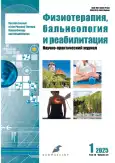利用惯性传感器对银屑病关节炎儿童步态的仪器分析
- 作者: Kan U.M.1, Laisheva O.A.1
-
隶属关系:
- N.I. Pirogov Russian National Research Medical University
- 期: 卷 24, 编号 1 (2025)
- 页面: 15-25
- 栏目: Original studies
- URL: https://journal-vniispk.ru/1681-3456/article/view/286134
- DOI: https://doi.org/10.17816/rjpbr632935
- ID: 286134
如何引用文章
详细
背景。仪器步态分析(Instrumental gait analysis, IGA)提供了一种客观且定量的方式来评估人体运动模式的特征。
研究目的。 研究患有银屑病关节炎(Psoriatic Arthritis, PsA)儿童的步态定量参数,利用惯性传感器识别早期诊断标志物,并评估其在医学康复中的应用潜力。
材料与方法。本研究纳入 34 名年龄在 11 至 17 岁之间的儿童。其中,研究组包括 17 名确诊为银屑病及银屑病关节炎的儿童(n=17);对照组包括 17 名无明显神经系统障碍及无影响步态生物力学的肌肉骨骼疾病的儿童(n=17)。 步态参数的记录采用 “Stedis” 训练系统,使用 8 个生物传感器,分别固定于双下肢的足部、小腿远端、大腿近端、骶骨以及第 12 胸椎水平处。在实验过程中,记录步态的时空参数和运动学参数。
结果。本研究对比分析了两组儿童的步态特征:对照组为无明显神经系统损伤或影响步态生物力学的肌肉骨骼疾病的儿童,研究组为确诊银屑病关节炎(PsA)的儿童。研究结果显示,与对照组相比,PsA 组儿童受累下肢的支撑期和单支撑期时间均有所延长。受累下肢的摆动期时间比健侧缩短约 1.5%。此外,受累下肢的足部抬升高度比健侧高出 5 cm。与对照组相比,健康儿童的健侧单支撑相时间高出近 4%。统计学差异具有显著性(p=0.009)。 PsA 组儿童受累下肢的摆动相时间比对照组儿童高 2.3%。统计学差异具有显著性(p=0.019)。 整体来看,对照组儿童的摆动相时间比 PsA 组儿童高近 4%。统计学差异具有显著性(p=0.019)。
结论。具有 PsA 特征的步态模式由特定的发病机制决定,其发展机制不同于其他类型的关节炎。
作者简介
Ulyana M. Kan
N.I. Pirogov Russian National Research Medical University
Email: polt2795@gmail.com
ORCID iD: 0009-0002-7445-9626
postgraduate student
俄罗斯联邦, 1 Ostrovityanova str, Moscow, 117997Olga A. Laisheva
N.I. Pirogov Russian National Research Medical University
编辑信件的主要联系方式.
Email: olgalaisheva@mail.ru
ORCID iD: 0000-0002-8084-1277
SPIN 代码: 8188-2819
MD, Dr. Sci. (Medicine), Professor
俄罗斯联邦, 1 Ostrovityanova str, Moscow, 117997参考
- Skvortsov DV. Diagnosis of motor pathology by instrumental methods: gait analysis stabilometry. Andreev TM, editor. Moscow, 2007. 640 p. (In Russ.)
- Roberts M, Mongeon D, Prince F. Biomechanical parameters for gait analysis: a systematic review of healthy human gait. Physical Therapy and Rehabilitation. 2017;4(1):6. doi: 10.7243/2055-2386-4-6
- Baker R. Gait analysis methods in rehabilitation. Journal of neuroengineering and rehabilitation. 2006;3(1):4. doi: 10.1186/1743-0003-3-4 EDN: PUURIU
- Berner K, Cockcroft J, Louw Q. Kinematics and temporospatial parameters during gait from inertial motion capture in adults with and without HIV: a validity and reliability study. BioMed Eng OnLine. 2020;19(1):57. doi: 10.1186/s12938-020-00802-2 EDN: LSSHXB
- Abbass SJ. Kinematic analysis of human gait cycle. Nahrain University, College of Engineering Journal. 2014;16(2):208–222.
- Mo S, Chow DHK. Accuracy of three methods in gait event detection during overground running. Gait Posture. 2018;59:93–8. doi: 10.1016/j.gaitpost.2017.10.009
- Ewins D, Collins T. Clinical Gait Analysis. Clinical Engineering Academic Press. 2014:389–406. doi: 10.1016/B978-0-12-396961-3.00025-1
- Hillman SJ, Stansfield BW, Richardson AM, Robb JE. Development of temporal and distance parameters of gait in normal children. Gait & Posture. 2009;29:81–85. doi: 10.1016/j.gaitpost.2008.06.012
- Kluge F, Gaßner H, Hannink J, et al. Towards mobile gait analysis: concurrent validity and test-retest reliability of an inertial measurement system for the assessment of spatio-temporal gait parameters. Sensors. 2017;17:1522. doi: 10.3390/s17071522
- Sass P, Hassan G. Lower extremity abnormalities in children. American Family Physician. 2003;36(3):22–27.
- Johnston L, Eastwood D, Jacobs B. Variations in normal gait development, Symposium. Surgery and Orthopaedics, Paediatrics and Child Health. 2014;24(5):204–207. doi: 10.1016/j.paed.2014.03.006
- Inman VT, Ralston HJ, Frank T. Human Walking. London: Williams and Wilkins; 1981.
- Kochergin SN, Tamrazova OB, Stadnikova AS. Analysis in children and employees of the Medical Council of the Republic. 2016;2:77–10.
- Alekseeva EI. Juvenile idiopathic arthritis: clinical picture, diagnosis, treatment. Current Pediatrics. 2015;14(1):78–94. doi: 10.15690/vsp.v14i1.1266 EDN: TIHOVF
- Chebysheva SN, Geppe NA, Zholobova ES, et al. Clinical features of psoriatic arthritis in childhood. Doctor.Ru. 2020;19(10):22–26. doi: 10.31550/1727-2378-2020-19-10-22-26 EDN: BRNISF
- Molochkov VA, Yakubovskaya ES, Mylov NM. Psoriasis and psoriatic arthritis. Clinic, diagnosis, treatment. Moscow: Monica; 2015. p. 26. (In Russ.)
- Lee K, Armstrong AU. Review of the results of treatment of patients with psoriasis. Dermatol Clin. 2012;30(1):61–72. doi: 10.1016/j.det.2011.08.012
- Adaskevich VP, Katina MA. Clinical features of psoriasis in children and adolescents. Medical Council of the Republic. 2018;2:83–88.
- Chen S, Lach J, Lo B, Yang G-Z. Toward pervasive gait analysis with wearable sensors: a systematic review. J Biomed Heal Informatics. 2016;20:1521–37. doi: 10.1109/JBHI.2016.2608720
- Iosa M, Picerno P, Paolucci S, Morone G. Wearable inertial sensors for human movement analysis. Expert Rev Med Devices. 2016;13:641-659. doi: 10.1080/17434440.2016.1198694
- Picerno P. 25 years of lower limb joint kinematics by using inertial and magnetic sensors: a review of methodological approaches. Gait Posture. 2017;51:239–46. doi: 10.1016/j.gaitpost.2016.11.008
- Mikhailova AA, Korchazhkina NB, Kotenko KV, Koneva ES. Experience in the use of robotic biomechanical medical rehabilitation techniques in patients after acute cerebrovascular accident. Problems of Balneology, Physiotherapy and Exercise Therapy. 2021;98(3-2):127–128. (In Russ.) EDN: OOEAJW
- Kotenko KV, Khan MA, Korchazhkina NB, et al. Modern non-drug technologies of medical rehabilitation of children. Moscow: GEOTAR-Media; 2022. 440 р. (In Russ.) doi: 10.33029/9704-7062-6-MTM-2022-1-440 EDN: IBGAKQ
补充文件











